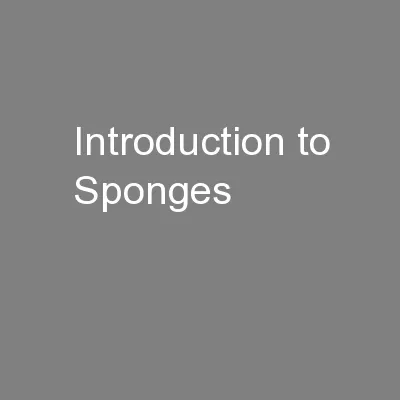

Porifera Porifera Porebearing Over 4000 species Mostly marine Classification Kingdom Animalia Plantlike in appearance Lack some typical animal characteristics Distinct tissues Dead end phylum ID: 274519
Download Presentation The PPT/PDF document "Introduction to Sponges" is the property of its rightful owner. Permission is granted to download and print the materials on this web site for personal, non-commercial use only, and to display it on your personal computer provided you do not modify the materials and that you retain all copyright notices contained in the materials. By downloading content from our website, you accept the terms of this agreement.
Slide1
Introduction to SpongesSlide2
PoriferaPorifera
“Pore-bearing”
Over 4,000 species
Mostly marineSlide3
Classification
Kingdom Animalia
Plant-like in appearance
Lack some typical animal
characteristics
Distinct tissues
Dead end phylumNothing evolved from the PoriferaSlide4
ClassificationOrganized into three classes
Based on skeleton structure differences
Calcareous sponges
Glass sponges
Encrusting spongesSlide5
Calcareous SpongesClassification
Class Calcarea
Size
Small, 4 inches or smaller
Location
Shallow watersSlide6
Calcareous SpongesStructure
Skeletons made of spicules
“little spikes”
Made of calcium carbonate
(lime)Slide7
Calcareous SpongesTwo types
Leucosolenia
Simple (asconoid)
canal systemSlide8
ScyphaAdvanced (syconoid) canal systemSlide9
Canal System FunctionSimple canal system
Water enters internal cavity (spongoceol) through pore cells in the body wall
Pore cell openings – incurrent openings (ostia)
Cells of the spongoceol absorb nutrients and oxygen
Water exits through excurrent opening (osculum)Slide10Slide11
Advanced canal systemFolded body wallsIncreases surface area
Greater absorption of nutrients and oxygenSlide12Slide13
Glass Sponges
Classification
Class Hexactinellida
SizeLarger, vase-shaped
Location
Deep, tropical watersSlide14
StructureSkeleton made of crystalline silicon dioxideGeometric pattern
Formed by six-pointed spicules
Possesses advanced canal systemSlide15
Encrusting SpongesClassification
Demospongiae (Demo – “people”)
Used as bath sponges
Size
Large
Location
Gulf of Mexico, Caribbean,
Mediterranean SeaSlide16
Encrusting SpongesStructure
Skeleton can be made of:
Elastic (spongin) fibers
Makes them “spongy”
Silicon dioxide
Combination of bothSlide17
Possess a complex (leuconoid) canal system
Commercial use
Collected by divers
Allowed to die/decompose in water
Spongy skeleton remains and is cleaned to be sold